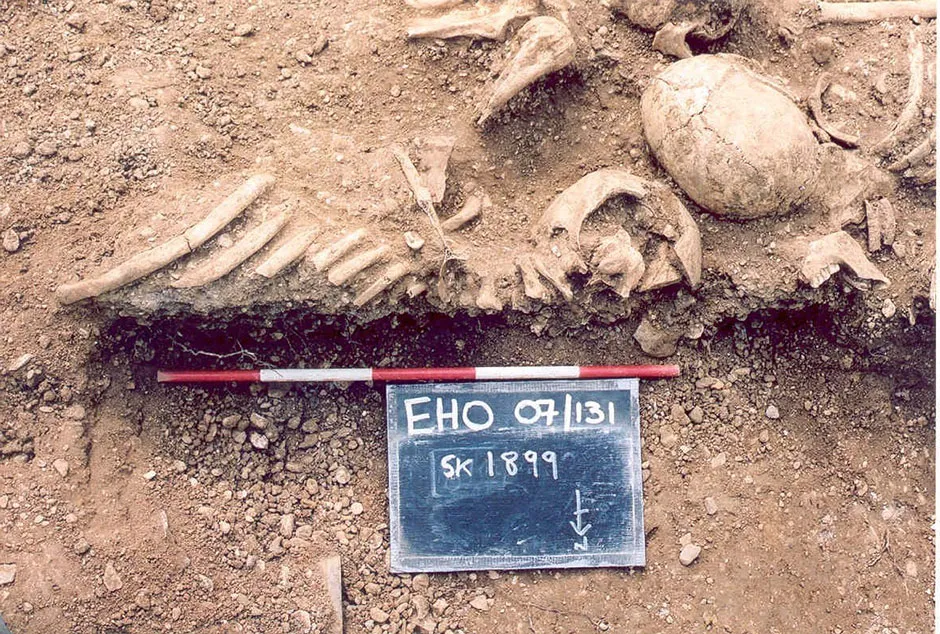Extinct strains of smallpox have been found in the teeth of Viking skeletons, indicating the disease was widespread in northern Europe during the 7th Century, scientists say.
An international team of researchers analysed the genetic material of the ancient strains and found their structure to differ from the modern smallpox virus which was eradicated in the 20th Century.They say the findings, published in the journal Science, pushes the date of the confirmed existence of smallpox back by 1,000 years.
The researchers believe Vikings may have helped spread the disease, although it is unclear whether these ancient strains were fatal.They say knowing more about the evolutionary history of viruses, such as the deadly smallpox, could help in the battle against new and emerging infectious diseases.
Read more about viruses:
- Epidemiology: the history of disease and epidemics (Part I, pre-20th Century)
- How do scientists develop vaccines for new viruses?
Dr Terry Jones, a computational biologist at the the Centre for Pathogen Evolution at the University of Cambridge and one of the authors of the study, said: “Knowledge from the past can protect us in the present.
“When an animal or plant goes extinct, it isn’t coming back. But mutations can re-occur or revert and viruses can mutate or spill over from the animal reservoir so there will always be another zoonosis (a disease which can be transmitted to humans from animals).”

Smallpox, caused by the variola virus, was one of the most virulent human diseases, killing more than 300 million people in the 20th Century alone.It became the first human disease to be eradicated in 1980 following an extensive global vaccination effort.However, concerns still remain over the re-emergence of the virus, with the possibility of another strain spilling over from animals at any moment.
Scientists say the origin and evolution of smallpox in humans remains a mystery, although some virologists believe the variola virus may have been first transmitted to humans from rodents thousands of years ago.To find out more, the researchers searched for evidence of ancient smallpox at various archaeological sites.

They found extinct strains of the variola virus in the skeletons of humans at 11 burial sites from the Viking era, in Denmark, Norway, Russia and the UK.More evidence of these viral strains were found in human remains in Oland, an island off the east coast of Sweden.
Analysis showed the genetic structure of the ancient smallpox strains to be “remarkably” different from the modern version, which, scientists believe, suggests that the virus may have evolved.

Study leader Professor Eske Willerslev, of St John’s College, University of Cambridge, said: “We discovered new strains of smallpox in the teeth of Viking skeletons and found their genetic structure is different to the modern smallpox virus eradicated in the 20th Century.
“We already knew Vikings were moving around Europe and beyond, and we now know they had smallpox. People travelling around the world quickly spread COVID-19 and it is likely Vikings spread smallpox. Just back then, they travelled by ship rather than by plane.”
Study author Professor Martin Sikora, from the Centre for GeoGenetics at University of Copenhagen, added: “While we don’t know for sure if these strains of smallpox were fatal and caused the death of the Vikings we sampled, they certainly died with smallpox in their bloodstream for us to be able to detect it up to 1,400 years later.”
Who really invented vaccinations?
In 1796, Gloucestershire physician Dr Edward Jenner conducted one of the most important, if unethical, experiments in medical history. His aim was to investigate claims that people could be protected from deadly smallpox if previously exposed to cowpox, an apparently related but harmless disease.
To find out, he risked the life of an eight-year-old boy (whom he had exposed to cowpox) by deliberately exposing him to smallpox. Apart from a brief fever following the cowpox infection, the boy remained healthy. Ever since, Jenner has been hailed as the discoverer of ‘vaccination’, a vital weapon in the fight against disease and one that led to the global elimination of smallpox in 1980.
The idea that prior infection gave ‘immunity’ against later disease had, however, been noted as early as the 10th Century by Chinese physicians. By the early 18th Century, Lady Mary Wortley Montagu, wife of a diplomat in Turkey, was advocating ‘variolation’. This involved deliberately exposing patients to smallpox-infected tissue. While often successful, the technique was risky, with around one in eight dying from smallpox.
Jenner was not even the first person to test cowpox as a way to provide immunity against smallpox. Even so, he deserves credit for studying the theory systematically, and convincing the Royal Society to publish his findings.
Read more: